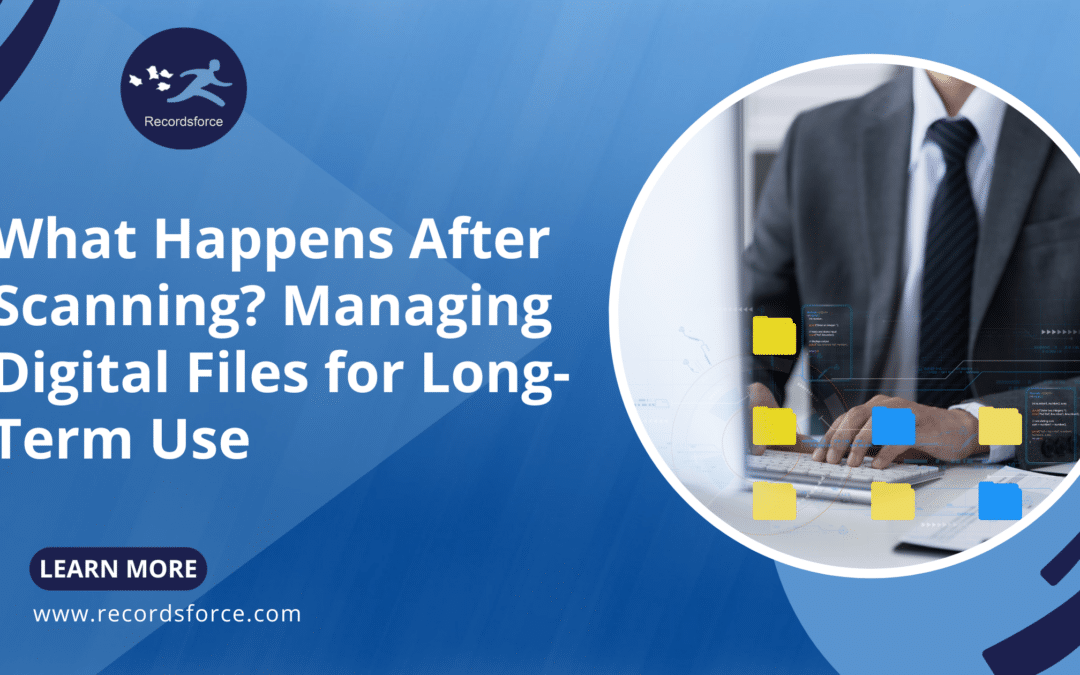Scanning paper documents into digital formats is just the first step in modern document management. Once your documents are scanned, effective management is crucial to ensure long-term accessibility, security, and organization. From post-scanning workflows to indexing and storage best practices, this blog explores how to efficiently manage digital files for ongoing use.
Post-Scanning Workflows
After scanning, documents are transformed into digital files that require proper management to maintain their integrity and usability. Here’s what happens next:
- Quality Assurance
- Once scanned, documents go through a quality assurance (QA) process to verify that all pages are legible and that no errors occurred during the scanning process.
- QA ensures the accuracy of the digital files, with manual checks and automated tools correcting any inconsistencies or missing information.
- Indexing
- Indexing is the process of assigning metadata to digital files, making them easily searchable and retrievable.
- Key information like document type, date, department, author, and related keywords are attached to each file, allowing users to quickly find what they need.
- Categorization and Organization
- Once indexed, files are organized into logical structures, such as folders or digital libraries, based on departments, projects, or content types.
- A clear folder hierarchy ensures that documents are easy to navigate and reduces the risk of misplaced or disorganized files.
- Security and Access Control
- Digital files must be secured with access controls, ensuring only authorized users can view or edit specific documents.
- Role-based permissions, encryption, and audit trails are implemented to safeguard sensitive information and comply with regulatory standards.
Indexing: The Key to Efficient File Management
Effective indexing transforms scanned documents into valuable assets by making them easy to locate and use. Best practices for indexing include:
- Consistent Metadata: Ensure that metadata fields are consistently filled in for every document to maintain organization and usability.
- Automation: Use of automated indexing solutions to accelerate the process and reduce human error.
- Validation: Regular audits of indexed data help maintain accuracy and relevance as documents are updated or archived.
Storage Best Practices for Digital Files
Once documents are scanned, indexed, and organized, proper storage ensures their longevity and accessibility. Here’s how to manage digital file storage for long-term use:
- Cloud Storage
- Cloud-based storage solutions provide flexibility, scalability, and remote access, making them ideal for businesses with distributed teams or remote workforces.
- Ensure the use of secure, encrypted cloud platforms with regular backups to protect against data loss.
- On-Premise Storage
- For businesses with sensitive data or specific compliance requirements, on-premise storage may be necessary.
- Implement robust internal systems with secure servers and disaster recovery protocols.
- Regular Archiving and Retention Policies
- Establish clear retention policies to manage digital files based on their lifecycle.
- Older, inactive documents can be archived to reduce storage overhead while maintaining access for future reference.
- Document Versioning and Tracking
- Maintain version history for critical documents, ensuring that older versions are preserved and easily accessible.
- Document tracking systems allow users to see who accessed or edited a file, providing accountability and traceability.
Benefits of Effective Post-Scanning Management
- Increased Productivity: Digital files are easier to locate and use, speeding up decision-making and collaboration.
- Improved Security: Proper indexing, categorization, and access control reduce risks associated with unauthorized data breaches or compliance failures.
- Reduced Physical Storage Needs: Digitization reduces the need for physical storage, saving space, time, and resources.
- Compliance and Auditing: Indexing and categorization simplify audits and ensure adherence to legal or industry-specific regulations.
Conclusion
Managing digital files after scanning is about more than just converting paper documents to digital formats—it’s about creating a structured, secure, and efficient system for long-term use. With effective indexing, categorization, and storage practices, businesses can maximize the value of their digital assets and ensure seamless access to critical information.
Recordsforce offers comprehensive digital mailroom solutions to help you streamline the scanning and post-scanning process, enhancing productivity, security, and overall document management. Learn more about how we can support your business needs today!

